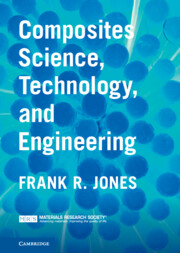Book contents
- Composites Science, Technology, and Engineering
- Composites Science, Technology, and Engineering
- Copyright page
- Contents
- Preface
- 1 Introduction
- 2 Fibres and Particulate Reinforcements
- 3 Matrices
- 4 Composites Fabrication
- 5 Mechanical Properties of Composite Materials
- 6 Mechanical Properties of Laminates
- 7 Fatigue Loading of Laminates
- 8 Environmental Effects
- 9 Joining, Repair, Self-Healing, and Recycling of Composites
- 10 Case Histories
- Index
- References
10 - Case Histories
Published online by Cambridge University Press: 14 April 2022
- Composites Science, Technology, and Engineering
- Composites Science, Technology, and Engineering
- Copyright page
- Contents
- Preface
- 1 Introduction
- 2 Fibres and Particulate Reinforcements
- 3 Matrices
- 4 Composites Fabrication
- 5 Mechanical Properties of Composite Materials
- 6 Mechanical Properties of Laminates
- 7 Fatigue Loading of Laminates
- 8 Environmental Effects
- 9 Joining, Repair, Self-Healing, and Recycling of Composites
- 10 Case Histories
- Index
- References
Summary
Since the discovery of carbon fibres in the 1960s, the applications have grown. Because of the high specific strength and stiffness, aerospace applications have dominated, especially initially in military aircraft. The intent here is to demonstrate how the choice of material has been identified. Most critical demonstrators have come from the field of aerospace because of the benefits of carbon fibres and the development of confidence in their use in safety-critical designs. The latter has involved much testing and durability studies. Middleton has provided several case histories detailing the development of composite applications in aircraft structures [1]. The use of composite components has increased with improved confidence in the durability and reliability of these materials and structures. The Airbus A380 was introduced in 2006 using a carbon-fibre-reinforced polymer (CFRP) centre wing box, while the fuselage employed an aluminium–glass fibre composite laminate (GLARE). The centre wing box is a critical carbon-fibre composite structure that joins the wings to the fuselage. Together with several other composite components, such as the horizontal and vertical stabilizers, keel beam, and pressure bulkhead, the total composite usage is 22% w/w. In 2011 the Boeing 787 Dreamliner employed carbon-fibre materials for the fuselage and wings. In total, the latter used 80–90% by volume or 50% by weight of composite materials. The Airbus A350, introduced in 2015, also uses CFRP for the fuselage and wings, and in total composite usage is 53% w/w.
- Type
- Chapter
- Information
- Composites Science, Technology, and Engineering , pp. 346 - 375Publisher: Cambridge University PressPrint publication year: 2022



